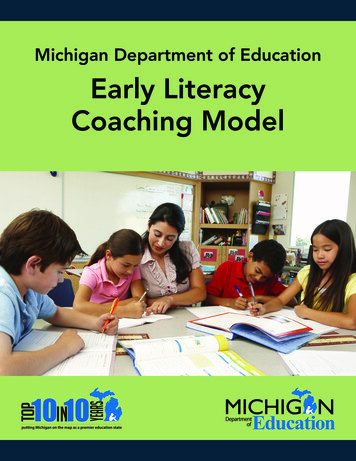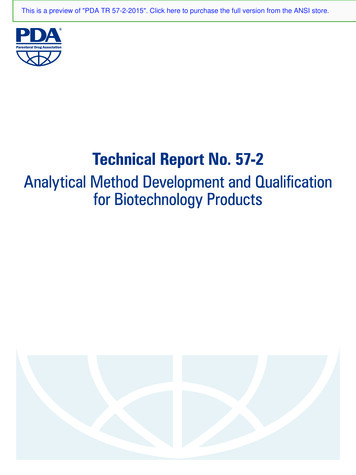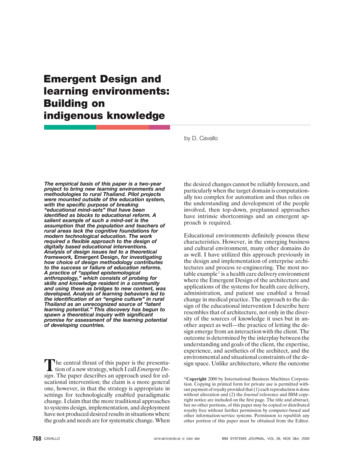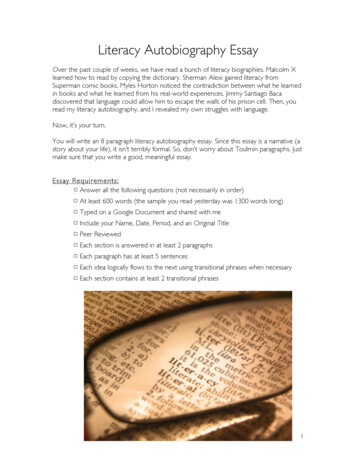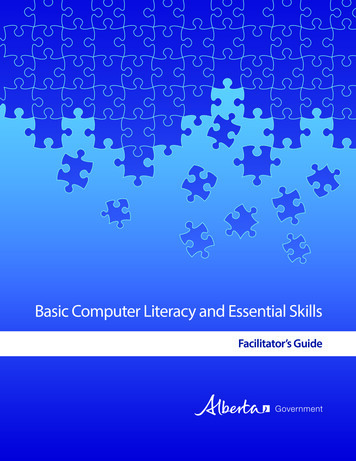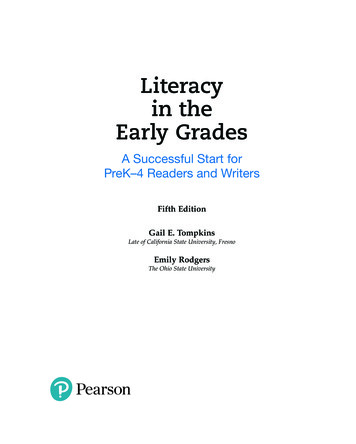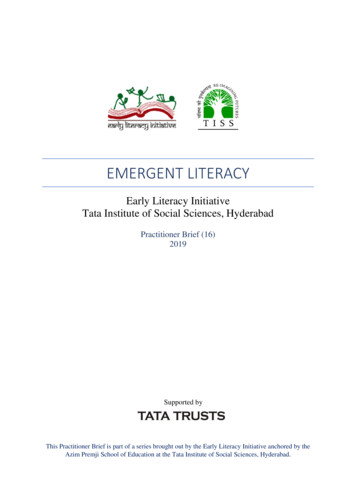
Transcription
EMERGENT LITERACYEarly Literacy InitiativeTata Institute of Social Sciences, HyderabadPractitioner Brief (16)2019Supported byThis Practitioner Brief is part of a series brought out by the Early Literacy Initiative anchored by theAzim Premji School of Education at the Tata Institute of Social Sciences, Hyderabad.
TISS, HyderabadELI Practitioner Brief 16Emergent LiteracyVignette 1:1On a regular weekday morning in August, students of Grade 1 are excited and impatient asthey line up outside class. The teacher has nearly finished setting up the room. The walls ofthe classroom are decorated with charts of aksharas, poems, story cards and to-do lists. Asoft-board exhibits children’s work. Another wall displays patterned cards with the names ofall 20 children in the group.The teacher sets down boxes with different kinds of paper, colours and other stationery in acorner labelled ‘लिखने का कोना’ ‘(writing corner). Once she is ready, she welcomes thechildren inside.Teacher: “सायमा, क्या तुम आज हमे बैग का कोना दिखाओगी?” (“Saima, will you please showus the Bag Corner today?”)Saima walks to the front left of the room, and reads from a label on the wall, tracing thewords with her fingers.S: बैग का कोना (The bag corner.)T: बहुत बदिया! (Very good!)The children leave their bags in the Bag Corner and arrange themselves in a circle. Afterevery child has joined the circle, the teacher asks, “Who would like to tell us about the othercorners?”Many children raise their hands. As the teacher calls out their names, different students walkup to different corners around the classroom. A label on the wall, put at the children’s eyelevel, denotes each corner.1The example has been inspired and adapted from observations at Organization for Early LiteracyPromotion, Ajmer1
TISS, HyderabadELI Practitioner Brief 16The children trace the writing with their fingers and read out —Child 1: कविता का कोना (Poem Corner)Child 2: लिखने का कोना (Writing Corner)Child 3: कहानी कोना (Story Corner)Teacher: कहानी कोना? (Story Corner?)The child looks at the label again and murmurs, “कहानी कोना ”.The teacher walks around him, picks up a book from a hanging books line, and repeats,“कहानी कोना?”The child takes the cue, looks at the label, and replies, “ककताबों का कोना, ककताबों का कोना!”(Books’ Corner, Books’ Corner!). And his hand trace the words again.This group of students have been members of Grade 1 for a month now. They belong to alow-literate rural community in India, where most children do not attend pre-school and donot come from print-rich environments. What we have just read describes their early morningritual at school.The Emergent Literacy PerspectiveWhen do children begin to become literate? If we were to ask you this question, you mightthink back to when you learnt to read and write; or you may think of your students and say,“3 years,” or “7 years”, or “5 years”. By contrast, the emergent literacy perspective suggestsFigure 1. Picture of a four-month old reading. Image Courtesy: Shailaja Menon2
TISS, HyderabadELI Practitioner Brief 16that with adequate exposure to print, children could start learning to read and write frombirth. How can this be? A new-born cannot even hold a pencil, a four-month-old doesn’tknow the aksharas. However, the emergent literacy perspective expands our understanding ofwhat it means to learn to read and write.Learning to read and write, according to this perspective, is more than learning the aksharasor to spell words correctly: we learn a lot more about print before we learn these specifics. Ababy surrounded by books and print at home learns from a very young age that print holdsmeaning for the people surrounding her. She may see her grandfather reading the newspaperevery morning. She may see her father filling out a form or reading a hospital report. Shemay see her mother reading bus numbers, or writing a letter, or counting out money. If she isin an environment where children’s books are available, she may learn to hold those booksand look intently at pictures while someone reads them aloud to her; and later on, read themherself (see Figure 1).Marie Clay, the well-known educator from New Zealand who coined the termEmergent Literacy, defined it as the skills, knowledge and attitudes children developabout reading and writing before they become conventional readers and writers.Assumptions of the Emergent Literacy PerspectiveThe emergent literacy perspective makes a few critical assumptions about how childrenbecome literate:1. Young children learn the functions of literacy through observing and participating inreal-life settings in which reading and writing are used.2. This requires active participation in meaningful activities.3. It also involves interaction with meaningful others.4. Young children don’t first learn to read and then learn to write; rather, they learnabout both reading and writing simultaneously, and development in one supports thedevelopment of the other.5. These abilities are linked to their oral language.6. Learning to read and write occurs continually over time and, upon close observation,we see children go through many developmental phases in learning to read and write.3
TISS, HyderabadELI Practitioner Brief 16Emergent Literacy in Low Literate SettingsMuch of the work in Emergent Literacy has been done in print-rich, middle-class,Western cultures. How does it translate to our cultures where many children are firstgeneration literates, with little to no print exposure at home?We would argue that, in these circumstances, the onus is all the more on earlylanguage classrooms to provide opportunities for children to be immersed in a worldof meaningful print. While creating these opportunities, it is important to incorporatethe children’s languages, cultures and experiences within the classroom if we wantthem to remain active and motivated explorers of language.We start with the assumption that all children, including those from low-literate settings, areactive meaning-makers, naturally motivated to observe and interact with the print in theirenvironment. Through this engagement, they pick up things that will help them along the wayto conventional literacy, including ideas about how language and literacy work. They buildon the oral languages that they bring to the classroom. They learn the functions of print—why we use print in our daily lives (e.g., to read road signs, make lists, read newspapers andbooks). They learn that there are rules for how print works, that many scripts may go fromleft to right, or from top to bottom. They learn to be attentive to the sounds in theirlanguage—how some words sound like others (rhyme, or words that start with the samesounds). They learn about aksharas and how to put them together to make words andsentences. They may learn that their initial attempts at scribbling could lead to drawing andwriting. There is so much to learn about the world of print!We won’t attempt to cover all these aspects in this brief. Instead, we will focus on three keyareas and hope that it will lead you to expand your understanding about the others. We willlook at:1. Creating awareness about print2. Providing opportunities for emergent reading3. Providing opportunities for emergent writing4
TISS, HyderabadELI Practitioner Brief 16Creating Awareness about PrintAs we mentioned earlier, children from low-literate communities do not have a lot ofexposure to print at home or in their surroundings. Thus, it is important that as their teacheryou provide students opportunities in the classroom to learn concepts about print.Concepts about Print is an awareness about how print works: that print conveysmeaning, that it is used for different purposes, and that it has different features, formsand conventions.The different kinds of understanding related to print are described next.Understanding the Relevance of PrintConsider what generally happens when children enter schools: they are taught the varnamalain a rote fashion for months at a stretch. Teachers may not even read out books, stories orpoems to them. In such cases, it is unlikely that children will come to see reading and writingas meaningful—they may not realise that the letters or aksharas they are learning cometogether to form words and sentences that tell a story or provide meaningful information.Here is an exchange between a researcher and a second-grade child about a picture book,reported verbatim from Menon et al.’s (2017) Literacy Research in Indian Languages(LiRIL), a study conducted in Yadgir, Karnataka.Researcher (R) (Holding up a picture book): “What is this?”Child (C): This is a “Copy” to read (“Copy” is the colloquial term for a notebook.)R: What will you find inside this?C: Words.R: What will you do with these words?C: Read them, then copy them down.(Excerpted from Subramaniam, Menon & Sajitha, 2017, p. 7).You can see that the child had no idea that one could look for meaning, a story, in the text.Children with print awareness, on the other hand, understand that learning to read and writehelps them convey meaning just as spoken languages do. They also know that print can be5
TISS, HyderabadELI Practitioner Brief 16used for different purposes like communicating with others, recording information, or readingfor pleasure and entertainment. Hence, perhaps the most crucial thing for children to learnabout print is that it carries meaning and has relevance in their lives.Understanding How Print WorksIt is important that students also learn how print within books works. Examples include:Directionality. All print moves in a particular direction. The direction of reading and writingin English and Hindi is from left to right, while in Urdu it is from right to left. When wereach the end of a line, we sweep back to the beginning of the next line. Show young childrenhow this happens; otherwise, they may write or read in random sequence.Learning how books work. Children, especially those from low-literate homes, may needexplicit help with understanding how books work (see Figure 2). This understanding wouldinclude: Knowing the different parts of a book (e.g. front, back, spine) and how to handle it(where to start reading and how to proceed). Knowing that pages of a book, with English, Hindi and many other Indian languages,are read from left to right and top to bottom. Pictures, charts or other graphics may accompany text. One has to look at all theseelements to form meaning from the book.Figure 2. A young boy browsing a book, holding it upside down, which shows limitedunderstanding of how books work. Image Courtesy: Akhila Pydah6
TISS, HyderabadELI Practitioner Brief 16Concept of a word. When we speak, we may let several words run into each other. Manychildren may think of these groupings as one word and may write them that way (a youngchild might write “thetisy” for “that is why”). On the other hand, children may also readakshara by akshara, not knowing to pause between words. The sentence, “मेरा नाम राम है ” canbe read out as “मे-रा-ना-म-रा-म-है ”, and reading it this way, without grouping aksharas intowords, might hamper a child’s understanding.Conventions. Conventions like punctuation marks affect the meaning and expressionconveyed by text. For example, the text “What happened?” might indicate a casual curiosity,while saying, “What happened?!” might indicate an urgent need for information.Knowing about Forms of Print MaterialThere are many forms of print: books, pamphlets, charts, labels and signage, notices, lists,letters and so on. Children have to understand the organisation, purposes and conventions ofthese various formats so that they can use them effectively.Creating Print Awareness through a Print-Rich EnvironmentOne way to help children learn more about how print works is to create a print-richenvironment in the classroom2. In the vignette presented at the beginning of this brief,Figure 4. Word wall. Organisation forEarly Literacy Promotion, RajasthanFigure 3. Picture dictionary. Sita School,Karnataka2Refer to ELI Practitioner Brief, Creating a Print-rich Environment in the Classroom for more detailson the types of print and the different ways to use them in the classroom. The brief can be accessed athttp://eli.tiss.edu/handouts-publications/7
TISS, HyderabadELI Practitioner Brief 16we saw that as students interact with the print in their classroom (e.g. reading the labels forspaces), they come to understand that it serves a purpose and works in specific ways. Table 1lists the kinds of print you could put up in your classroom and their use or function.Table 1Types of Environmental Print Recommended in an Early Language ClassroomType of Environmental PrintPrint That Labels Things or Spaces-Labels that tell students what things are or where things belong—‘blackboard’,‘writing corner’, ‘space for notebooks’, etc.Print That Reminds Students What to Do-Little notes of instructions, such as rules for the classroom, daily duties, print thatreminds students how to use a particular thing or space (e.g. “Please keep the booksback in the same place after reading them” and “Shh you are in the readingcorner”)Print That Informs Students-Alphabet / varnamala charts-Picture-dictionary charts with names and pictures of common things (see Figure 3)-Word walls with cards of words your class commonly uses or encounters (e.g.amma, mama, baba, gaay, ghar, paani, kitaab, etc.); you can add pictures sochildren can make connections more quickly (see Figure 4)-Children’s names displayed in a large and bold type on a wall-Children’s work (like their drawings, writing, art etc.), with descriptionsPrint that Asks Students to Respond or Contribute-Daily attendance sheets (see Figure 5)-Sign-up sheets (where students sign up for a task)-Class schedule, used every morning to discuss the plan for the day with students-Shared writing charts3, which are accounts of shared experiences the teacher helpsthe class compose and write-Poem charts and story posters based on texts students have recently read or heard;students love “reading out” these posters to friend3Shared Writing is described in detail later in the brief.8
TISS, HyderabadELI Practitioner Brief 16Spaces for Reading and Writing: Reading-, Writing- and Word-study Corners4These corners help children explore and interact intimately with print and literate worlds- A reading corner, or classroom library, is well-stocked with children’s books forstudents to browse and read on their own- The writing corner is a space where students can scribble, draw, write, cut-and-paste,stamp, and otherwise engage with print using a variety of material- In the word-study corner, children get material and opportunities to make and breakwords, think about how sounds and symbols are connected. You can club it with thewriting corner, if there is a space constraintFigure 5. This is a picture of a daily attendance chart. Children have not yet learnt to write their names,but they are able to identify it and sign against it using symbols such as dots, crosses or the first aksharaof their names. Kamala Nimbkar Balbhavan, Pragat Shikshan Sanstha, Phaltan, Maharashtra.Sometimes, teachers create a print-rich environment in the classroom but forget to use itmeaningfully. A print-rich environment is not a decorative display of print. If children are toengage meaningfully with it and learn from it, then print needs to be used meaningfullythroughout the day. Let’s recall the vignette at the beginning of this brief: the teacherincorporated the use of labels or written instructions into the classroom routine (childrenidentify spaces for bags and leave their bags there every day). You could think of similarways to engage students with classroom print.4The ELI practitioner brief on print-rich environment presents the required material and suggestedactivities for each of the three corners.9
TISS, HyderabadELI Practitioner Brief 16It is also best to position print at children’s eye-level and make it easily accessible. Keep theclassroom print dynamic and responsive to what is happening in class. This means regularlychanging or updating displays according to students’ learning needs and progress.Providing Opportunities for Emergent ReadingMany of us may have seen children pretending to read books, even though they don’t knowhow to read letters or words. What are they doing? Perhaps they are looking at the picturesand trying to make sense of them. Perhaps they are trying to imitate adults around them,turning pages, tracking print with their fingers as they read. Perhaps they remember a bookread aloud to them by an adult and are retelling the story from memory. Or perhaps they haveactually learned to read a few words and are attending intently to the print.Emergent reading refers to a whole range of behaviours children exhibit with print and booksbefore they learn to read conventionally. Through many exposures to print and books, andthrough many interactions with the adults and other children around them using this print,children learn useful things about how to read. Print awareness, discussed earlier, is a part ofthis learning, but there are other aspects as well.Initially, while pretend-reading books, children may focus only on looking at individualpictures. Slowly, they may realise that the pictures are connected and they may try to tell astory from the pictures. Through meaningful interactions with books in the presence ofsupportive adults and peers, children gradually begin to understand that the story lies inreading the pictures and text together. This is a new understanding.If the adults around the child narrate stories to her and read books to her, she will also learnthat stories have a predictable structure—that they have a beginning, middle and end. Shemay realise that stories always have characters and actions. With repeated exposure tostorytelling and read-alouds at home and school, she begins weaving her own narratives(stories).10
TISS, HyderabadELI Practitioner Brief 16Supporting Emergent Reading in the ClassroomGames to build children’s phonological awareness. Even before children learn to readaksharas representing different sounds, it is important that they become aware of how soundswork in the spoken language. You can play a variety of quick, interesting games or use oralrecitations of poems and rhymes to build this phonological awareness5 in them.Engaging with classroom print. As we discussed earlier, engage your students withclassroom print, such as by pointing out labels, reading out poems and stories, engaging withdisplays of their work, playing interesting games with words on the word wall and picturedictionaries6. Don’t worry about whether children are actually reading the letters or words.Let them read from memory or by sight. Over time, they will begin attending to words andletters.Shared Reading. Choosing a big book, or a story or poem poster with large font andillustrations. Read the text multiple times over a couple of days, and track the text word byword with a pointer as you read it out (see Figure 6). Children follow along and join inwherever they can. This helps them understand concepts about print like directionality, howto turn pages and how to attend to pictures and print together. In later readings of the text,you can point out specific features of words, letters or punctuation.Figure 6. Shared Reading of a big book. QUEST, Maharashtra.5Refer to ELI practitioner brief Supporting Phonological Awareness in Pre-primary and PrimaryClassrooms for more on the concept and the many ways to support it: http://eli.tiss.edu/handoutspublications/6The ELI practitioner brief on print-rich environment presents many suggestions for engagingstudents with classroom print.11
TISS, HyderabadELI Practitioner Brief 16Daily read-alouds. Children best learn about print when they are reading and writing in real,authentic contexts (Clay, 1991). Participating in read-alouds of good books is one suchpowerful experience. It benefits all aspects of literacy learning. But, at the most fundamentallevel, it shows children how print represents spoken language, how one handles a book andhow to make meaning out of a longer, connected text. And all this happens in a warm,pleasurable context. So try to read aloud with your students every day. Use a wide variety ofbooks – it will help them see different ways of communicating meaning through print.Picture reading. Children can be encouraged to read pictures. Single pictures with lots ofinteresting action in them can help children generate stories. But it is equally important togive children wordless picture books that show a sequence of actions that help them weave astory as they read.Reading corners or classroom library. Allow students to freely explore and browse throughbooks of their choice in the reading corner. Remember to include books you have alreadyread aloud to the class. Encourage children to look at the illustrations, ask questions, retellstories from books they liked from read-aloud sessions, or write or draw in response to thosebooks.Word cards. These consist of words and their illustrations. As we said earlier, even whenchildren are unable to decode, they will guess the names of words by looking at the pictures.You can play word games using these cards. For example, ask students to sort the cards bybeginning sounds or ending sounds. Later, when you introduce aksharas, write a couple ofthem in different spaces on the floor; ask students to say the name of the word or picture oneach card and place it in the correct space for the beginning (or ending or middle) akshara.Display these cards in an easily accessible place (e.g. a word wall) and encourage children torefer to them when they want to read or write some of these words.Playing games with akshara cards. Make cards with one akshara written on each one, andplay letter games to draw children’s attention to the akshara symbol and its sound. Toreinforce this learning, Organization for Early Literacy Promotion encourages children tocreate a train (or rail in Hindi) of aksharas: as children learn a new akshara, they drawpictures of as many words as they can think of beginning with that akshara. The क ki rail12
TISS, HyderabadELI Practitioner Brief 16may consist of kap, katori, kainchi, kabootar, kaagla, kanghi, and so on (see Figure 7). Ifstudents want, they can also attempt to write names of things against the pictures (emergentwriting, see next section), or they can refer to picture-dictionaries or word walls for this.Figure 7. A child making his rail for the akshara क. OELP, RajasthanProviding Opportunities for Emergent WritingJust as children pretend to read before they can read conventionally, they also engage invarious forms of emergent writing behaviours before they begin to write conventionally.Young children’s writing is related to their talk, drawing, reading, and pretend-play. In herextensive work with young writers, Ann Dyson (1988) noted that young children interweavegestures, talk, drawing and scribbling when they first begin to write. They may pick up a toytruck, move it around on the ground, making “vrroom, vrroom, beep, beep, beep!” sounds asthey zig zag the truck on the floor. They may also narrate a complex story about the truck totheir friend, and finally make a few marks on paper, representing only a small part of whatthey are trying to convey.Similarly, they might “write” random scribbles that don’t make sense to adults but when youask them about their scribbles, they may have much to say (See Figure 8). Over time, theymay begin scribbling letter-like forms, mixing these with their drawings7. These areRefer to the ELI blog piece Children’s writing: How does it emerge and why is it significant? forphases of emergent writing in an Indian language. You can access it here: merge-and-why-is-this-significant/713
TISS, HyderabadELI Practitioner Brief 16important first steps—it may take years before children are able to produce writing that looksconventional to an adult. However, it is important that you are attentive to children’s earlyattempts at writing and support them.Figure 8. Scribbling of random shapes by a child in the beginning of Grade 1, and what she saysabout her writing as transcribed by the researcher and presented in translated forms in English andHindi. Image Courtesy: LiRIL study report, Menon et al, 2017.Children write about emotionally important topics. If you assign topics for writing in yourclassroom, you may have noticed that young children often appear to go off topic and writeabout issues emotionally important to them. In the LiRIL study (Menon et al., 2017), a childdrew his father when he was asked to write or draw in response to the photo of a balloonseller (see Figure 9). Notice how the child has labelled the image: “Mera papa mera” (mydad mine). Though he went off-topic, he was clearly using print to explore and express hisfeelings. Such attempts should be permitted; otherwise, children may not find writing to berelevant, and may be reluctant to write at all.Figure 9. The writing prompt on the left and a child’s response to it—Mera papa mera (my fathermine). Image Courtesy: LiRIL study report, Menon et al, 2017.14
TISS, HyderabadELI Practitioner Brief 16Children gradually learn about the relationships between symbols and sounds. Initially,children may not understand that letters represent sounds of spoken language. However,understanding this symbol-sound relationship is crucial to the development of literacy andthere are many interesting ways of bringing children’s attention to it. With instruction andexposure, once children begin recognising this relationship, they start exploiting thisknowledge to spell words.Figure 10. Use of invented spellings by a four-year-old to convey his message - I made orangewith red and yellow. Image Courtesy: Poorva AgarwalTheir early spellings may not be correct in the conventional sense, but these inventedspellings demonstrate that children are trying to problem-solve the relationship betweensounds and symbols. In Figure 10, a four-year-old writes “MAD” for “made”, “ORANJ” for“orange”, “WID” for “with” and “YELO” for “yellow”—such clever attempts to encode thesounds of his message in writing. It is critical that you encourage children in these initialattempts at writing rather than simply supplying them with the correct spellings. This willhelp to strengthen their foundational understanding about writing.Supporting Emergent Writing in ClassroomsChildren need to be encouraged to write frequently and freely through throughout theemergent phase (and beyond). Ensure that you give them many opportunities to write abouttopics meaningful to them, and support them in their attempts at writing. We discuss some15
TISS, HyderabadELI Practitioner Brief 16ideas that you can use in your classroom8. Although we present these activities in separatesections, they benefit both reading and writing because both develop in an interrelatedmanner.Opportunities to draw, scribble, write, talk. Give children blank paper right from their firstday at school and ask them to draw and write. You could ask them to draw or write about theirhouse, surroundings, family; their response to a story you have shared with them; or anexperience they have shared together as a class. Let children scribble if they wish to, or draw apicture. Once they are done, ask them what they have written. Write down what they say, anddisplay this dictated writing along with their drawings in class (See Figure 11 and 12). You canread these examples of dictated writing back to the child, or share them with other children.This will help your students understand that their writing is valued and that what they write canbe read by others.Figure 11. A three-year old’s emergent writing attempts and teacher’s notes to record the child’sutterances about their writing. Image Courtesy: Shailaja Menon.Responding to classroom print. As a classroom routine, children can sign against their nameson the attendance chart (see Figure 5). Or they can volunteer for tasks in the classroom bysigning up for them, or respond to a survey displayed in class9.We only present a few key ideas here. The ELI practitioner brief Supporting Children’s Writing inEarly Grades elaborates on the principles for teaching writing and offers detailed suggestionsteachers can use to support students’ writing. Access the brief here: http://eli.tiss.edu/handoutspublications/9Examples of these are given in the brief Creating Print-rich Environment in the Classroom.816
TISS, HyderabadELI Practitioner Brief 16Modelled and shared writing. The class and you could compose a text together—about ashared experience or a class visit. You could write it down for the class on chart paper. By doingthis, you are modelling how to compose and write the text describing their experience andthoughts. Modelled writing is an excellent time for drawing attention to the use of text featuresand conventions. Hang the chart in the class and use it for repeated shared readings. As you readand re-read the text together, children will learn many things about how print works and how towrite. In later sessions, as you write, encourage children to share the writing process by addinga word, phrase, punctuation mark, or by showing how a new sentence should begin.Exposure to different genres of writing. Over time, read a wide variety of books to children,and encourage them to write in different genres. On one day, they can write a descriptive storyof a festival celebrated in their village. On another, you can show them how to write a letter to afriend telling her what the child appreciates about her. On a third occasion, you can helpchildren create rules for the classroom, or support them in writing their first poems. Throughoutthis, remember that writing becomes conventional only over time. Le
or to spell words correctly: we learn a lot more about print before we learn these specifics. A baby surrounded by books and print at home learns from a very young age that print holds meaning for the people s
